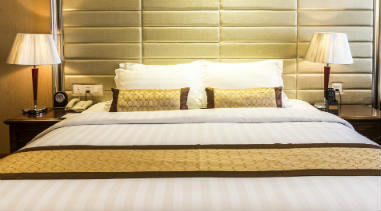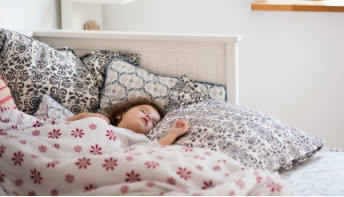It seems that viscose and rayon always get into a tight competition that baffles a lot of consumers on how these two fabrics are different from one another and at some factors, can be pretty identical. As viscose and rayon have been quite popular in the fabric industry, unraveling the definitions, their origin, and how they are produced inevitably become the highlights.
A vast array of beddings are labeled with viscose, rayon and sometimes both, as part of the content. But sifting through their properties, how do viscose and rayon differ from one another? Are there any distinct differences or viscose is just another moniker for rayon? Mind-boggling it truly is.
Puzzling as it seems, viscose and rayon are semi-synthetic fibers that make up a huge wedge of soft and comfortable bed sheets today on the market. Rayon and viscose are both derived from the manufactured fibers of regenerated cellulose. Through intricate procedures and a variety of grades, such fabrics can mimic the softness, texture, and feel of cotton, silk, linen, and wool.

What is Viscose?
Viscose or viscose rayon fiber is widely used in producing a variety of dresses, clothes, and other kinds of outerwear. Due to its texture and durability, it has also been used in upholstering, making carpets, and cellophane casting.
To break the confusion, the definition of viscose covers two factors: it is a method that uses a viscous or thick cellulose solution to produce a fiber commonly known as viscose rayon or simply as rayon. It also refers to the fiber itself; it is the specific kind of rayon fiber that goes through the viscous process and hence the name, viscose.
The integral portion of cellulose that produces viscose fibers is cotton. But the source may also vary from bamboo, sugarcane, and soy. That’s why it can deliver the same texture and feel like cotton but when it comes to the appearance, it looks a lot like silk.
What is Rayon?
Rayon is derived from a manufactured fiber or commonly referred to as the regenerated cellulose. Delving a little bit more into this aspect, a cellulose is the integral component of plant cell walls. Rather than the plant itself, the cellulose used in making rayon is obtained from the tree itself or the wood pulp.
Through the intricate chemical process, the cellulose, an insoluble substance, transforms into a soluble substance which eventually solidifies and becomes purified. This purified cellulose becomes rayon.
Rayon lends a soft and smooth texture and feel such as linen, wool, silk, and cotton. It is among the versatile fibers you can find out there. Due to its absorbency, cool feeling, and comfort properties, it becomes one of the ideal options to use during the hot and humid season.
What are the differences between Viscose and Rayon?
As viscose and rayon are both derived from natural sources such as cotton and bamboo, they are often labeled as natural fibers. But, in fact, these two fabrics are semi-synthetic. To come up with the sheets, beddings, and clothes, viscose and rayon undergo a substantial and thorough chemical process that conflicts and compromises with its natural form.
Putting viscose and rayon side by side for comparison can unravel gaps and similarities. But getting a bit closer to their characteristics, it’s apparent that these two fabrics aren’t really battling for preeminence.
As they are both manufactured from regenerated cellulose, provide a comfortable and soft feel such as cotton, wool, and silk, and go through an extensive chemical process, there isn’t much of a big deal.
Perhaps the major difference between viscose and rayon is the source of materials used. Viscose can be sourced from a variety of plants while rayon is usually from wood pulp. Viscose, on the other hand, is known as an artificial silk describing its silk-like appearance. Rayon, however, looks and feels like cotton.
Is Viscose a Rayon?
It isn’t a concrete yes but viscose and rayon are rather interchangeable. It was in 1924 when the term “rayon” has been considered as another name for “viscose” referring to the viscous method that uses a thick liquid to produce rayon and cellophane.
The US Federal Trade Commission has also cited “viscose” as an alternative name for “rayon”. Therefore, considering their properties and definitions, viscose and rayon are similar and different at some point.

Breaking It Down
To rule out the differences and similarities between viscose and rayon, I’ve jotted down the significant factors that define their overall quality: material, appearance, maintenance, and cost.
Material
Viscose
Viscose is usually derived from cotton but can also be extracted from bamboo, sugarcane, and soy. Rather than wood pulp, viscose is sourced from a variety of plants.
The production, however, is quite complex and through a substantial process that involves a viscous solution or viscous liquid, this manufactured fiber of a regenerated cellulose becomes the viscose fabric.
It carries a certain durability standard that’s been used in making memory foam, upholstery, carpets, industrial yarns, and cellophane. Apart from these products, viscose has also been a common source in producing various types of clothing such as dresses, outerwear, jackets, coats, and a lot more.
Rayon
Unlike viscose, the cellulose for producing rayon is typically derived from the wood pulp or the tree itself. It goes through a fundamental and thorough process to convert the insoluble cellulose to a solidified and purified compound.
Rayon features beneficial properties that have been the basis for producing different types of clothing and other materials. It is breathable, versatile, absorbent, and can be dyed easily.
Appearance
Viscose
Viscose has also been known as an artificial silk due to its silk-like appearance. It features a smooth and soft texture that can provide a comfortable and cozy feeling. Just like silk, it drapes beautifully and feels light. It also carries breathability properties leaving the fabric cool without any hot spots.
Although described as durable and strong, viscose also has its drawbacks that consumers should take note of. When it gets wet, the fibers may not be as strong as they should be. It can also wrinkle and shrink easily over time.
Rayon
Rayon resembles cotton – the appearance and how it feels like. With just a subtle touch, you can feel a soft and smooth texture just how cotton does. Other types of rayon can also lend the same texture and feel such as wool, silk, and linen. It is versatile, easy to dye, and highly absorbent.
If you’re searching for a fabric for the hot or humid season, rayon is one of the ideal options. With its breathability, it gives off a cool feeling without leaving a muggy feeling on your skin.
Just like any other types of fabric, rayon also has disadvantages. Although it is durable at some point, it may also shrink and pill over time, especially when it is washed or gets wet. Extensive heat exposure may also damage the fabric.
Maintenance
Viscose
As a fabric that showcases a silk-like appearance and texture, viscose is considered a delicate fabric that requires gentle washing. It is recommended to be hand washed or dry cleaned to prevent pilling and shrinking. Do not squeeze the water out. Just hang it flat and let it dry.
If you prefer washing it in a washing machine, make sure to opt for the delicate preset and use a gentle detergent. However, manufacturers always provide detailed instructions on how you should wash a particular viscose garment. If there’s any, follow the recommended method.
Rayon
As the properties of viscose and rayon are seemingly alike, it is reasonable to think that rayon also belongs to the vast lineup of delicate fabrics. Just like viscose, a rayon fabric or garment should also be gently washed in a cold water and mild detergent.
To retain its form, it should not be harshly squeezed to let the water out after washing. Hanging it dry or air dry is the recommended method.
Handwashing is preferable. If you’re using a washing machine, don’t forget to use the gentle or low spin cycle. But if you’re washing a particular clothing or garment, always refer to the detailed instructions from the manufacturer for the recommended procedure.
Cost
Viscose
Viscose is one of the most affordable fabrics you can find on the market. As a low-cost fabric, it’s been quite accessible for everyone to try and use the items made from viscose.
However, there are available items, particularly clothes and garments that are blended with other types of fabric such as cotton, polyester, elastane, and many more which might alter the range of prices.
Rayon
Rayon is rather inexpensive fabric. With a wide range of rayon styles and colors, there certainly is a garment that will comply with your preferences and style perfectly.
Similar to viscose, the price range may also vary depending on the blend and type. There are clothes or sheets that are made of 100% rayon while other kinds are blended with cotton, polyester, and other materials. Imported rayon fabrics may also come with a higher price range.
What Are the Best Viscose Sheets in 2018?
100% Bamboo Viscose Sheet Set by Royal Hotel Review
If you wish to give your bed sheets a beautiful and luxurious revamp, the Royal Hotel bed sheets are probably the one you need.
Made from 100% bamboo viscose material, it provides a soft, silky, and lavish quality that you can snuggle yourself in for a comfortable sleep.
These bamboo viscose bed sheets are incredibly soft and comfortable to sleep in, especially in the hot or humid season.
It is breathable and leaves your skin with a cool feeling. With its silky and smooth texture, people with allergies or sensitive skin can take delight in these comfy sheets.
Hundreds of positive reviews from the consumers highlight its quality, incredible softness and smoothness that leave a superior comfort and cozy feeling even during the cold nights.
Read real reviews on Amazon
What are the Best Rayon Sheets in 2018?
100% Rayon from Bamboo Sheet Set by Hotel Sheets Direct Review

The Hotel Sheets Direct bamboo bed sheet set is made of 100% rayon and truly deserves a spot in the best-selling list.
It showcases softness and light feeling that gives off superior comfort while you sleep in it. As it is derived from bamboo, it also ensures a quality that you can use for many years to come.
During the hot season or humid days, these bamboo rayon bed sheets can keep you cool without leaving any hot spots or sticky feeling.
Consumers also pointed out its hypoallergenic properties that will benefit people with allergies and sensitive skin. This bedding set promises incredible softness and cooling properties that will definitely give you a superb sleeping experience.
Read real reviews on Amazon
Pros and Cons of Viscose and Rayon
Viscose Pros
- Incredibly Smooth and soft like silk
- Versatile
- Breathable
- Provides a cozy and comfortable feeling
- Affordable
- Can be used in making dresses, various kinds of clothing, bed sheets, outerwear, upholstering, carpets, and cellophane
Viscose Cons
- Requires gentle washing
- Can wear out or pill if not maintained properly
Rayon Pros
- Smooth and soft like cotton
- Breathable
- Highly absorbent
- Versatile
- Easy to dye
- Provides a comfortable and cozy feeling
- Affordable
- Can be used in making various kinds of clothing
Rayon Cons
- Should be treated gently
- May shrink if not properly washed

Conclusion
Although there have been tons of reviews that put up the characteristics of these stunning fabrics for comparison, Viscose and rayon both possess beneficial properties that are truly remarkable in terms of comfort, cost, and overall quality.
But in regards to their striking similarities and differences, determining which fabric is better than the other seems to be a matter that everyone can’t just brush off.
If you’ve been following the definitions closely, here are the important notes you should know: Viscose and rayon are semi-synthetic fabrics.
Although they’re both derived from natural sources like bamboo and cotton, the extensive chemical process they go through compromises their natural properties making them more manmade than natural.
Viscose is a type of rayon but it is also an alternative name for Rayon.
Confusing as it is, Viscose and rayon may be two different kinds of fabrics but, at times, they can be identified as the same fabric. When manufactured as bed sheets, these stunning fabrics lend incredible softness, smoothness, and a luxurious quality that can treat you with an ultimate sleeping experience.






Pingback: Viscose Rayon vs Polyester Key differences] What's Better for You?